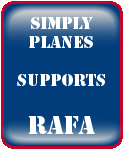Supermarine Spitfire
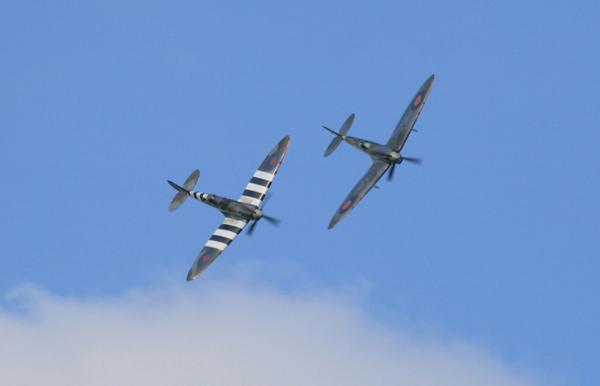
Supermarine Spitfire Tr Mk IX G-LFIX ML407 (OU-V) The Grace Spitfire and Mk IX G-ASJV MH434 (ZD-B) at Duxford Spring Air Show 2008. Photo by Bruce Martin
The legendary Supermarine Spitfire, probably the most popular British aircraft. Originally designed as a single-seat fighter aircraft, some Spitfires have been converted to two-seaters. The Supermarine Spitfire first flew in 1936 and was the only allied fighter produced throughout World War II being used until the 1950s. Over 20000 Supermarine Spitfires were built.
The Spitfire was designed by R. J. Mitchell (the chief designer at Supermarine Aviation Works) as a short-range interceptor fighter. The elliptical shaped wing of the Spitfire enabled it to reach a much higher speed than the Hawker Hurricane and many other fighter planes. The iconic Spitfire has gone down in history as being the most favoured victor of the Second World War, but in fact the Hawker Hurricane defeated a higher number of the Luftwaffe.
The Spitfire was used in a number of roles after The Battle of Britain, including as a carrier-based fighter, fighter-bomber, interceptor, photoreconnaissance and a trainer. It was built in many different variants, with two different types of engine and several wing configurations. Two of the main variants of the Spitfire were the Seafire and the Spiteful.
Airworthy Supermarine Spitfires
Supermarine Spitfire Mk Vb AB910 (RF-D)
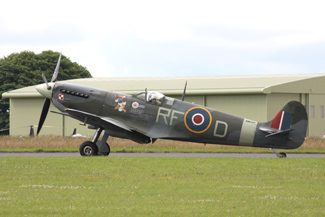
AB910 was built in 1941 and served on the front line for nearly four years. On 14th February 1945 AB910 took off from Hibaldstow Airfield with a member of the ground crew sitting on the tailplane and carried out a short circuit and landed back safely. The aircraft was donated to The Battle of Britain Memorial Flight in 1965 and is still currently with them now, based at Coningsby in Lincolnshire.
The Battle of Britain Memorial Flight website
Photo by Bob Franklin
Supermarine Spitfire Mk Ia G-AIST AR213 (JZ-E)
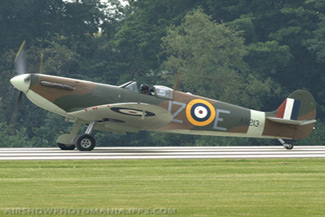
AR213 was one of the last production Mk I Spitfires and was built by Westland and used in the training role. After being struck off charge AR213 spent many years in storage at Old Warden Airfield, before being restored to flying condition for filming of The Battle of Britain film in 1967.
Photo by Colin Sayce - Airshowphotomania.ifp3.com
Supermarine Spitfire Mk Vb G-MKVB BM597 (JH-C)
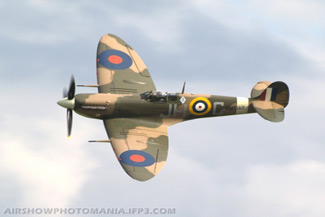
BM597 is a combat veteran and was amongst the 1000 aircraft built at Castle Bromwich. On 26th February 1942 she was delivered to No. 37 M.U at Burtenwood. Later she was assigned to 315 Sqn on 7th May 1942 and also 317 Sqn on 5th September 1942, both at Woodvale.
BM597 suffered Cat B damage on 13th February 1943 and was ready to be collected by No. 33 M.U on 9th June. She was allocated to Vickers-Armstrong for an undisclosed reason.
BM597 was moved back and forth between No. 39 M.U and No. 222 M.U High Ercall (packaging depot), being stored at No. 39 M.U for almost a year until it was issued to No. 58 OTU. No. 58 OTU was its last operational unit. BM597 was retired on 16th October 1945. After this BM597 was transferred to instructional airframe status at No. 4 S of TT, St. Athen as 5713M.
BM597 was next assigned to Hednesford between 1950-1955, also Bridgenorth between the years of 1955-1960 and finally Church Fenton between 1960-1989 as a gate guardian.
On 23rd January 1967 BM597 was dispatched from Henlow to Pinewood, where she was used as the master for the moulds that were created to cast the fibre glass replicas used in The Battle of Britain film.
BM597 remained at Pinewood until August 1968, when she was returned to Henlow and then moved on to Church Fenton in 1969. In 1989 Tim Routsis (the founder of Historic Flying) recovered BM597 as part of a deal with the RAF and then sold it to The Historic Aircraft Collection in 1993. Historic Flying undertook the complete restoration to the original specification of the aircraft. She now flies in the colours of 317 Sqn, but in an earlier camouflage paint scheme.
In September 2005 Supermarine Spitfire BM597 became the first Spitfire to return to the Mediterranean island of Malta since the filming of Malta Story in 1952. She flew there alongside Hawker Hurricane Z5140 as part of the Merlins Over Malta project.
Supermarine Spitfire BM597 is kept in Hangar 4 at the Imperial War Museum at Duxford in Cambridgeshire.
BM597 has a Rolls-Royce Merlin 45 engine with 1440hp, with a range of 470 miles (756km), a maximum speed of 374 mph (602 km/h) at 13000ft (3960m) and is equipped with two 20mm Hispano cannons and four .303 Vickers machine guns.
Historic Aircraft Collection website
Photo by Colin Sayce - Airshowphotomania.ifp3.com
Supermarine Spitfire MkLF Vb G-LFVB EP120 (AE-A)
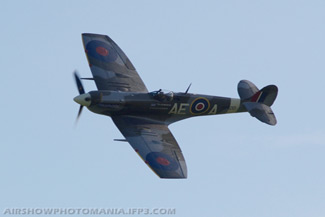
EP120 is one of only four airworthy examples of the Mk V Supermarine Spitfire in the world, but there are other Mk Vs undergoing restoration at the moment.
EP120 was taken on charge to the RAF in 1942 and she spent time with 501 Sqn where she accounted for a Do 17 at the hands of the Wing Commander.
EP120 then spent some time with 19 Sqn in Cornwall and was later moved to 402 RCAF Sqn. During this time the Squadron Commander had changed and the new boss of the station adopted EP120 as his machine, she was also flown by other squadron pilots during the time she was with 501. After joining 501 Sqn, in his first year Squadron Leader Geoffrey Northcott shot down seven German aircraft, six of them while he was flying EP120. At seven kills EP120 is the most credited Mk V in existence and possibly the most credited WWII fighter.
EP120 was returned to Castle Bromwich for repair work after an accident whilst she was flying with 501 Sqn. EP120 was allocated to OTU for a ground instructional role and also several gate guardian posts after serving with 19 Sqn and 402 RCAF Sqn.
EP120 was used as a static aircraft in The Battle of Britain film in 1967-1968. Then she was on the gate at RAF Wattisham in Suffolk, whilst there she was restored. Then the RAF moved her to RAF St Athan in South Wales, where she joined other Spitfires in store.
In 1993 The Fighter Collection liberated her from St Athan. She was airframe overhauled by Historic Flying at Audley End. She flew again in 1995. In July 1996 EP120 took part in the Duxford Flying Legends Air Show, she has flown on a regular basis since that time.
In 2000, EP120 took part in the film Pearl Harbour as the lead Spitfire.
EP120 has a 1470hp Rolls-Royce Merlin 55M liquid cooled V-12 cylinder engine, with a range of 475 miles (765km) and a maximum speed of 357 mph (575 km/h).
The Fighter Collection website
Photo by Colin Sayce - Airshowphotomania.ifp3.com
Supermarine Spitfire Mk IX G-CCCA IAC-161 formerly PV202 (H-98)
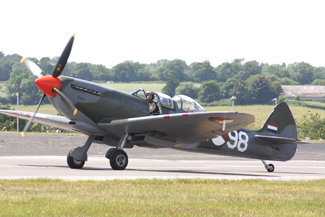
IAC-161 was built at the Castle Bromwich factory of Vickers Supermarine as a single-seat LFIX fighter. She was built in 1944 as part of contract No. B981687/39. She was delivered to the Royal Air Force at No. 33 Maintenance Unit at Lyneham in Wiltshire as PV202 on 18th September 1944, where she was brought up to operational standard for service delivery.
She was moved to No. 84 Ground Support Unit at Thruxton, Hants. On 19th October 1944 she entered service with 33 Sqn. 135 Wing of 2nd Tactical Air Force which is based at Merville in Northern France, where she carried the codes 5R-Q. 33 Sqn had the task of ground support of offensive operations while the allied forces pushed further on into Europe and also the harassment of enemy troop movements by carrying out strafing attacks on rail and road convoys. She next moved to her new base at Maldegem in Belgium, then she returned to the UK on 14th December 1944 at 84GSU, Lasham when the squadron converted to Hawker Tempests.
During her service with 33 Sqn PV202 carried out twenty operational sorties with ten pilots from Britain, Denmark, Holland and South Africa. PV202 next went to Dunsfold in January 1945 to join 83GSU, shortly after being issued to 412 Sqn. Royal Canadian Air Force operating from Heesch in Holland, here she carried the squadron markings VZ-M, which was later changed to VZ-W. Due to the continuation of the squadron's task of strafing anything enemy that was moving on the ground the squadron moved further into Germany, they were based at the Rhein and Wunsdorf forward operating airfields. On 4th May 1945 Fg Off H.M.Lepard carried out the last of PV202's 76 operational sorties with 412 Sqn. The squadron returned home with the war in Europe at an end, it returned back to Dunsfold at the end of May and she was flown to the famous 29MU at High Ercall to be put into storage during July 1945.
PV202 stayed at High Ercall until 1950, when she was chosen by Vickers-Armstrong for conversion into trainer configuration as part of the Irish Air Corps. PV202 was converted at their Eastleigh factory and was test flown as G-15-174. The delivery to the Irish Air Corps was completed on 15th June 1951 where she obtained her new identity as IAC-161.
The Irish Air Corps used the Tr.9 Spitfires to train pilots for the IAC Seafire fleet, this course included gunnery practice. After some time the IAC retired its Seafire fleet and the Tr.9 Spitfires was retired in 1960. The majority of these moved on to a ground technical training school at Baldonnel to be used as instructional airframes to train aircraft engineers for the Air Corps. IAC-161 was in this role from December 1960 until she was sold to Tony Samuelson, a collector who was supplying aircraft for The Battle of Britain Film Company.
Samuelson bought four Tr.9 Supermarine Spitfires from the IAC, two of these Spitfires were made airworthy and in the filming IAC-161 stayed on the ground and was never used in the film, she remained at Cricklewood in storage. Tony Samuelson sold his four Spitfires along with an airworthy Hawker Hurricane in April 1970 to Sir William Roberts. IAC-161 was moved to a farm at Flimwell, at a later date the fuselage of the aircraft was moved to Shoreham. Shortly after this it went to The Strathallan Collection Aircraft Museum in Scotland.
In 1979 IAC-161 and ML407 (IAC-162), her sister aircraft were put up for sale, they went to Nick Grace who moved them both to St Merryn in Cornwall. He kept IAC-162 for himself and sold IAC-161 to Steve Atkins, who moved various parts of the project to a barn on a farm at Saffron Walden. Whilst she was in Saffron Walden, a group of volunteers including Aircraft Restoration Company engineer Kevin 'George' Francis and Aircraft Restoration Company (ARC) volunteer Bob Sparkes were involved in commencing the mammoth job of restoring the Spitfire to fly.
IAC-161 was moved to Sussex due to Atkins having a change of business. IAC-161 was restored as a two-seater aircraft, but with a modified rear canopy arrangement. After various struggles she was fully rebuilt. She made her first post-restoration flight on 23rd February 1990 from BAE at Dunsfold in 412 Sqn colours as PV202, marked as VZ-M. Around this time Atkins handed over the ownership of the aircraft to shareholder Richard Parker, he went on to operate her around the air show circuit until he sold it to collector Rick Roberts on 14th July 1992.
Whilst she was under the ownership of Roberts she was based at Goodwood. During this time she suffered an undercarriage malfunction. After the repairs to the undercarriage at Earls Colne the aircraft changed her colours to the previous 33 Sqn markings as 5R-Q. In March 2000 the aircraft was sold to Greg McCarrach with the intention of exporting it to his base in South Africa, she was written off in a fatal accident at Goodwood on 8th April 2000, killing both the owner and his instructor.
IAC-161 was moved for a crash investigation to Farnborough. After the investigation was complete the salvage was offered for sale and it was inspected by ARC and Historic Flying Ltd (HFL) engineers to decide whether a rebuild of the aircraft was possible. The wreckage was bought by the owner of HFL, Karel Bos. It arrived at the ARC workshop at Duxford on 28th February 2001, a partial strip down was undertaken before it was moved into the new ARC/HFL hangar in June 2001. Since that time a comprehensive rebuild has been undertaken by a team of ten engineers at HFL. The decision was made by Karel Bos to present the aircraft in the colour scheme she wore when she was delivered to the IAC in 1951, and to also convert her back to her original configuration with the bubble top rear canopy. The original rear canopy was able to be tracked down to a store in Norfolk and was obtained for the project. A Rolls-Royce Merlin 66 engine was rebuilt in America by Paul Szendroi of Universal Airmotive to replace the previously fitted Packard 266 Merlin, which is an American built engine. The Merlin 66 is the correct engine for this Mk of Spitfire.
During February 2004 the aircraft rebuild was complete and the first engine runs were undertaken on 27th February. The team were under the impression that she would be ready for her debut for the upcoming air show season, but due to the failure of a component the whole engine had to be removed to undertake this repair. By December 2004 she was once again ready for engine runs, after full testing and power runs she took to the air from Duxford on 13th January 2005 in the hands of John Romain, ARC Managing Director and pilot. After more extensive testing IAC-161 was awarded her permit to fly by the CAA. She broke into the air show scene in 2005.
In March 2007 the Dutch had her painted in the Royal Netherlands Air Force colours and she now represents H-98, one of three Spitfire trainers sold to the Netherlands in March 1948. She showed off her new colours at the Antwerp Air Show in May.
The Aircraft Restoration Company website
Photo by Bob Franklin
Supermarine Spitfire Mk IX G-ASJV MH434 (ZD-B)
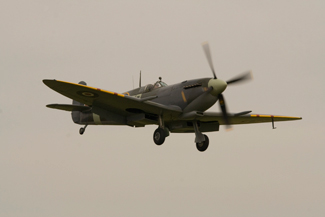
MH434 was built in 1943 at Vickers, Castle Bromwich. MH434 served with 232 and 350 Squadrons. She completed 79 operational sorties before being retired in 1945. The aircraft also served with the Royal Netherlands and Belgian Air Forces. In 1956 the aircraft was put up for sale and moved back to the UK. After being overhauled she was used purely for pleasure flying by her new owner. In 1968 it was time to join the cast for The Battle of Britain film, and in April 1983 she was put up for auction and bought by the late Ray Hanna and became The Old Flying Machine Company's founder aircraft and can still be found at Duxford Airfield near Cambridge.
The Old Flying Machine Company website
Photo by Ross Cannon
Supermarine Spitfire Mk IX G-BMSB MJ627 (9G-P)
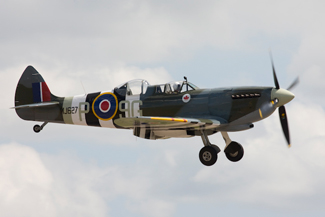
MJ627 was built at Castle Bromwich in 1943 as part of serial batch MJ602 to MJ646 as an LF.IXc and fitted with a Rolls-Royce Merlin 66 engine. Her first flight was on 27th November 1943. She was delivered to 9 MU at Cosford, Shropshire on 4th December 1943 and then put into storage.
On 13th March 1944 she arrived at General Aircraft for checks in works, most likely at Hanworth, Middlesex. She entered service with 441 (Silver Fox) Sqn. RCAF on 25th September 1944, she served with the RAF from the advanced landing ground B70 in Belgium. She was given the codes 9G-Q. In her first operational sortie she was flown by Flt. Lt A.A. Smith with a patrol in the Venloe/Nijmegen area. On 27th September 1944 Plt. Off. Bregman took off in MJ627 to patrol the Arnhem area. Bregman destroyed one Bf 109 out of the fifteen Bf 109s and Fw 109s that engaged east of Arnhem at 6000ft. Still with 441 Sqn MJ627 took part in the following sorties in the latter part of 10th November 1944.
On 27th December 1944 441 Sqn was posted to Skeabrae, Orkney Islands, Scotland for the defence of the fleet. MJ627 had a forced landing in Heather due to engine problems on 9th March 1945. She was declared a Category E, then changed to a Cat B, beyond repair on site. At this point her total flying hours were 245.05. On 11th September 1945 she was sent to Air Service Training (AST) in Hamble, Hants for repairs. On 28th February 1946 she was issued to 29 MU at High Ercall in Shropshire for storage.
MJ627 was sold to Vickers-Armstrong Ltd on 19th July 1950 and was moved to Southampton, Hants by road. They converted her to a T9 trainer and she wore the B-conditions marking G-15-171 before joining the Irish Air Corps at Baldonnel, near Dublin as IAC-158 on 5th June 1951. She was withdrawn from IAC service with 1036.10 flying hours on 20th April 1960.
She was delivered to Elstree, Herts on 13th November 1963. Next she was registered as G-ASOZ to Film Aviation Services on 19th February 1964, though she did not fly in this guise but was used as spares for Mk.IX MH434 (G-ASIV). She was bought for spares by Tim Davies in September 1964 and stored at various locations until 1976.
MJ627 was bought in 1976 by Maurice and Peter Bayliss, a long-term restoration was undertaken at Kenilworth where she was fitted with a Rolls-Royce Merlin 76 engine. On 3rd May 1978 she was registered as G-BMSB.
She was moved to Coventry, Warks in 1989 for assembly at Dollar Air Services hangar and she had her first engine runs in 1992. On 8th November 1993 she made her first post-restoration flight with Squadron Leader Paul Day in the cockpit, which was timed to coincide with its original first flight fifty years before at Castle Bromwich. She was finished in 441 Sqn colours, coded as 9G-P with invasion stripes.
On 6th May 1994 she was flown to Bruntingthorpe, Leics and was lodged in the main hangar alongside Avro Vulcan XH558 and Handley Page Victor XM715. On 6th August 1997 she was flown to Coventry, which was going to be her new base.
MJ627 crash landed at Coventry Airport on 25th April 1998 after a demonstration. On 14th February 2002 Squadron Leader Paul Day carried out a post-repair air test and landed at Coningsby, Lincs. On 7th May 2003 MJ627 flew into her new base at The Lincolnshire Aviation Heritage Centre at East Kirkby, Lincs.
MJ627 has taken part in various air shows since then. On 27th July 2008, MJ627 along with two other Tr.9 two-seat Supermarine Spitfires (ML407 and PT462) took part in an episode of the BBC's television programme Top Gear, where James May, Jeremy Clarkson and Richard Hammond arrived in formation for a race.
Photo by Ian Bracegirdle
Supermarine Spitfire Mk LFIXe MK356 (UF-Q)
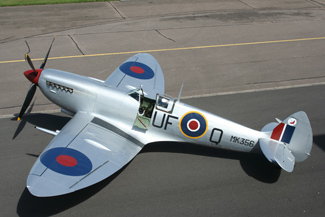
MK356 was built in March 1944 and allocated to 443 Hornet Squadron part of 144 Canadian Wing, which was commanded by Wing Commander (Johnny) Johnson. After the war MK356 was used as a static exhibit before being refurbished and flown for the first time in 53 years. MK356 is now part of The Battle of Britain Memorial Flight.
The Battle of Britain Memorial Flight website
Photo by Bob Franklin
Supermarine Spitfire Tr Mk IX G-LFIX ML407 (OU-V) The Grace Spitfire
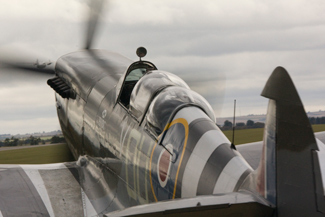
ML407, 'The Grace Spitfire' was built at Castle bromwich in 1944 as a single-seater and flew 176 operational combat sorties in the last year of World War II. This particular Spitfire was credited with shooting down the first enemy aircraft over the Normandy Beachhead on D-Day, while being flown by Flying Officer Johhnie Holton DFC. ML407 served with various squadrons including Polish, Belgian, Free French, Norwegian and New Zealand.
ML407 was converted to a two-seat Spitfire in 1950 at Southampton for the Irish Air Corps so she could become an advanced trainer. She remained with the IAC until 1960. ML407 was used in The Battle of Britain film and later sold to the Strathallan Museum. In 1979 ML407 was bought by engineer Nick Grace from the museum. Nick spent five years restoring her to flying condition as a two-seat Spitfire. The restoration was completed in 1985. ML407 took to the skies once again on 16th April 1985.
Nick flew ML407 at various air displays and she was used in the filming for the films 'Perfect Lady' and 'Piece of Cake'. In 1988 Nick Grace was tragically killed in a car accident. After this his widow Carolyn Grace learned to fly ML407. This can be seen in the film 'Going Solo'. Carolyn finished her training in 1990. She got her Display Authorisation in 1991 and she has also achieved aerobatic and formation qualifications since. Carolyn's son Richard Grace has learnt to fly The Grace Spitfire in recent years.
The Grace Spitfire is based in Hangar 2 at the Imperial War Museum, Duxford in Cambridgeshire. ML407 is maintained by a team of engineers at Bentwaters in Suffolk. Carolyn has flown ML407 at various air shows including at Duxford in a diamond 16, as part of the 'Big Wing' formation with 23 Spitfires and also in a diamond 9 to celebrate 90 years of flying at Duxford.
ML407 featured in the BBC's television programme Top Gear on 27th July 2008 with two other Tr.9 Spitfires, MJ627 and PT462. James May, Jeremy Clarkson and Richard Hammond were in the three Supermarine Spitfires.
Photo by Ross Cannon
Supermarine Spitfire Mk IIA G-AWIJ P7350 (XT-D)
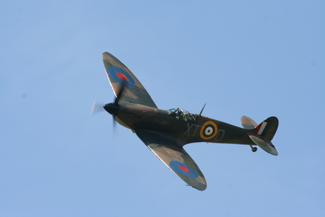
P7350 is the oldest Spitfire in the world and the only Spitfire still flying today to have fought in The Battle of Britain. She was sold for scrap in 1948 for £25 and later presented to the RAF museum in Colerne, then restored to flying condition for The Battle of Britain film and later presented to the BBMF.
The Battle of Britain Memorial Flight website
Photo by Bob Franklin
Supermarine Spitfire Mk IX G-IXCC PL344 (TL-B)
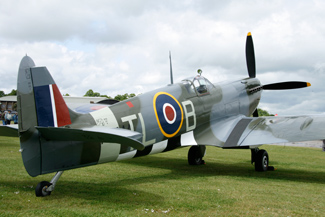
PL344 was built at Castle Bromwich in February 1944. After a restoration on 11th March 1991 she had her first flight at Micheldever and was registered as G-IXCC.
In September 1992 PL344 was sold to Kermit Weeks to be used in the Weeks Air Museum in Miami, she was moved to Personal Plane Services (PPS) at Booker, Buckinghamshire for further work to bring her up to stock condition. PL344 was fully fitted with gun bays and original radios. She flew once again at Booker on 17th October, piloted by Jonathan Whaley. PL344 was painted with 442 Sqn RCAF in late 1944 to early 1945.
PL344 was sold to Tom Blair of Southern Leasing Inc. Aerofab, Bartow, Florida. During May 2001 she was dismantled at Wycombe Air Park, Booker, Buckinghamshire and crated up for its journey to the USA. Once it had been transported by sea to Aerofab it was reassembled during the latter part of 2001, PL344 was given the USA registration of N644TB. Her first US flight was on 18th January 2002, she had engine failure on 8th April 2002 and the engine had to be rebuilt.
As of 20th January 2005 at Bartow, Florida PL344 was wearing new squadron codes TL-B, these codes reflect the name of the owner Tom Blair.
On 4th December 2006, PL344 flew in formation with recently arrived Mk.XIVe RN201 at Kissimmee, Florida. John Romain piloted PL344, while Cliff Spink piloted RN201. PL344 was dismantled and shipped in a container to ARC at Duxford, arriving on 12th January 2007 for an overhaul and a new colour scheme. PL344 was up in the skies once again after a few weeks, in the hands of John Romain.
On 15th January 2008 PL344 was registered as G-IXCC. She took part in the Duxford Flying Legends Air Show on 12th July 2008 as part of a twelve-ship formation flight of Spitfires. PL344 also took part in Duxford's 90th Anniversary Air Show, as one of nine Spitfires and a Seafire flying on both the 6th and 7th September. PL344 has also been a static display at various Duxford Air Shows on the flightline walk.
Photo by Bob Franklin
Supermarine Spitfire PR MK XI 6S/504719 G-MKXI PL965
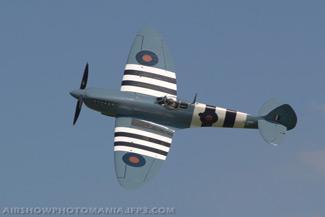
PL965 was built as a Mk XI photoreconnaissance aircraft and was designed to operate at high altitudes (over 30000ft) and at high speeds of over 400mph.
PL965 was operated by 16 Squadron based at Melsbroke Airfield in Belgium. Some of the missions flown by 16 Squadron Spitfires were to monitor airfields where jet and rocket propelled aircraft were operating from.
PL965 flew over forty operational missions over Germany, France and Holland. On some of these missions she encountered anti-aircraft fire and was often intercepted by German fighters.
Photo by Colin Sayce - Airshowphotomania.ifp3.com
Supermarine Spitfire Mk PRXIX PM631
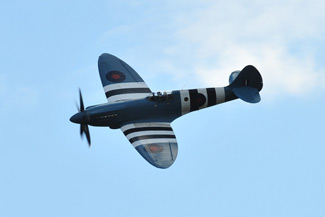
PM631, built in 1945 as a high altitude photoreconnaissance aircraft and fitted with a Griffon engine. The aircraft joined The Historic Aircraft at Biggin Hill in 1957. PM631 has remained in flying condition and is the BBMF's longest serving aircraft.
The Battle of Britain Memorial Flight website
Photo by Bruce Martin
Supermarine Spitfire Mk PRXIX G-RRGN PS853

PS853 was built at Southampton and delivered to the Central Photographic Research Unit at Benson on January 13th 1945. The aircraft was later converted for photoreconnaissance and joined Short Brothers and Meteorological Flight in July 1950, remaining with the flight until retiring in 1957. Over a period PS853 also served on the station flights at Biggin Hill and North Weald. PS853 became West Raynham's gate guardian until 1961, when she was transferred to the BBMF in April 14th 1964. In 1968 she took part in The Battle of Britain Film. The aircraft is now owned by Rolls-Royce.
The Rolls-Royce Spitfire website
Photo by Colin Sayce - Airshowphotomania.ifp3.com
Supermarine Spitfire Mk PRXIX F-AZJS PS890 (UM-E)
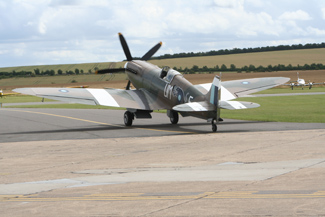
PS890 was built at Southampton. She was built as a PR.XIX with a Griffon 66 engine at Supermarine Aviation (Vickers) Ltd in 1944 and given production prototype engine mount modifications on 29th November 1944. She arrived at 6 Maintenance Unit on 9th April 1945.
On 30th April 1945 she was moved to RAF Benson (PRU) for storage. PS890 then joined 542 Sqn on 13th June 1945, followed by 81 Sqn at Seletar in Singapore on 22nd January 1951. She was next transferred to the Royal Thai Air Force (RTAF) as U14-26/97 on 3rd June 1954. PS890 was donated in 1962 to Ed Maloney of The Air Museum at Claremont, California, USA by King Bhumibel and she was put into storage.
PS890 was fitted with a Shackleton engine and retained contra-rotating propellers during a rebuild. She flew once again in May 2002 operated by Planes of Fame, Chino, under the registration N219AM. PS890 was bought by Christophe Jacquard and based at Dijon-Darois, France.
PS890 took part in Duxford's Flying Legends Air Show on 10th July 2005, with nine Spitfires taking part in total. On 4th June 2006, PS890 was at the Cerny, La Ferte-Alais Air Show in France. She also took part in Duxford's Flying Legends Air Show 2007 and also the 2008 Air Show.
PS890 underwent an overhaul between 2008-2009 at Dijon-Darois, France. The contra-rotating propellers were replaced with a five blade propeller and the engine was also replaced with another Rolls-Royce Griffon. She was given a new camouflage paint scheme, that of 152 Sqn with the codes UM-E of South East Asia Command during World War II, including a motif over the roundel of a 'Leaping Leopard'.
On 28th May 2009 she flew into La Ferte-Alais, Paris alongside Christophe Jacquard’s Focke-Wulf Fw 190 A-8N for the air show taking place that week. The Fw 190 A-8N had to be grounded due to a fault. PS890 took part in a formation flight of nine Spitfires and a Seafire on 11th July 2009 at the Duxford Flying Legends Air Show. On 5th September 2009 she took part in the Oldtime Fliegertreffen (Fly-meet) at Hahnweide Aerodrome, Kirchheim, Southern Germany.
Photo by Ross Cannon
Supermarine Spitfire Mk PRXIX PS915 The Last
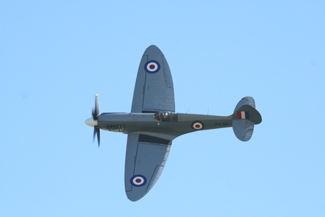
PS915 'The Last' entered service after the war and was used for testing new types of cameras. She was also used for flying strategic reconnaissance sorties in Europe, and for nearly thirty years served as gate guardians around the country. She has been modified to take a Shackleton Griffon 58 engine. PS915 is now part of The Battle of Britain Memorial Flight.
The Battle of Britain Memorial Flight website
Photo by Bob Franklin
Supermarine Spitfire Mk IX G-CTIX PT462 (SW-A)
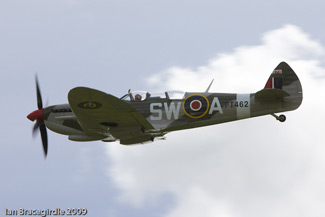
PT462 was built at Castle Bromwich in 1944 as a completed HF.IXe. This was the high-altitude sub-type of the Mk.IX series, which was developed to counter the Focke-Wulf 190. The HF.IXe was a derivative of the Mk.V, incorporating the 'universal' two-cannon, two-gun wing, with the stiffer metal-skinned ailerons. The superior performance of the HF.IXe came from the bomber-derived Merlin 70 engine with an anti negative-g, Bendix-Stromberg injection carburettor and four-bladed propeller.
She moved to 39 MU on 21st July 1944 and then to 215 MU Packing Unit at Tinwald Downs, Dumfries on 31st July. She went by sea to Mediterranean Allied Air Force arriving on 23rd August. She was with 253 Sqn marked as SW-A in April 1945, at this time the unit had been based at Canne, Italy. She moved in early April 1945 to Pkros in Yugoslavia, returning to Brindisi, Italy during mid-May 1945. Around mid-May 1947, 253 Sqn disbanded at Treviso. On 16th February 1947 the RAF identify was replaced by a AMI serial number (Matricola Militare) MM4100. She was overhauled by Ambrosini at Foggia and ferried to Israel in April in 1952 for IDFAF as 0607, later 2067, callsign 4X-FOM. She was recovered from Kibbutz, Gaza Strip in May 1983 and shipped on to Robert 'Robs' Lamplough in Fowlmere, Cambridgeshire.
She was sold to Charles Church, Winchester in July 1984. The aircraft had to undergo a rebuild which started on 9th April 1985 at Dick Melton Aviation near Popham. New wings were used for the rebuild from Trent Aero Engineering and also a tail section manufactured by Air Repair of Bicester. During this rebuild the aircraft was converted to a Tr.9 with a two-seat configuration. This was done by moving the front cockpit thirteen inches forward and inserting a second pilot's position in the narrow rear fuselage, she was also fitted with a Merlin 66 engine. PT462 first flew again as G-CTIX on 25th July 1987 but she landed wheels-up during a CAA flight test, this was partly due to a poorly positioned rear cockpit undercarriage-selector.
PT462 flew with Dick Melton Aviation for the next few years until she was exported to the USA. PT462 was at The Battle of Britain Salute Show at Boscombe Down and Biggin Hill Air Fair during 1990. She was also flown by Raymond Baxter during 1990 and in the summer of 1990 she took part in a commemorative event at RAF Northolt, including Supermarine Spitfires AR213, MJ730 and ML407. She also appeared at Middle Wallop and Badminton. PT462 was then re-engined with a transport-specification Packard Merlin 224, with a single-stage, two-speed supercharger and fitted with a new propeller.
She was sold in 1994 to Bill Goldstein of Jetcap Aviation Corporation in Lakeland, Florida and registered as N462JC.
PT462 was sold to Anthony Hodgson based in Rhyl, Wales. She arrived back in the UK but just missed out on being in Duxford's Spitfire Day in 1998 because she was not cleared through customs. She was on static display in Hangar 5 waiting to be rebuilt with the code SW-A of 253 Sqn. She was reassembled by John Romain at ARC, Duxford. Her first flight after reassembly was on 5th August flown by John Romain.
On 20th May 1999 she flew in formation with RAF Valley based Hawk T.1 XX172. PT462 now wears a Welsh dragon motif above her fin flash. She took part in the Duxford 60th Anniversary Battle of Britain Air Show on 9th and 10th September 2000, with 21 Supermarine Spitfires and three Hawker Hurricanes, she was flown by Anthony Hodgson.
During 2001 the renowned wartime Spitfire pilot Zbigniew ‘Adam’ Wojd returned to the air in one of the famous fighters, courtesy of Anthony Hodgson and the Dragon Spitfire Flight. Wojd, a veteran of the RAF’s famous 303 (Polish) Squadron made the trip in the rear seat of PT462 from Sleap, Shropshire. On 5th and 6th July 2002, PT462 took part in the Air Display at Jurby Airport on the Isle of Man.
Dragon Flight's PT462 took part in the Museum of Flight's annual Air Show at East Fortune, Edinburgh on 12th July 2003. PT462 was part of the flightline walk along with nine other Spitfires and a Seafire at Duxford's 70th Anniversary Spitfire Air Show on 2nd September 2006. PT462 featured in the BBC's television programme Top Gear on 27th July 2008, with two other Tr.9 Spitfires MJ627 and ML407. James May, Jeremy Clarkson and Richard Hammond were in the three Supermarine Spitfires.
Photo by Ian Bracegirdle
Supermarine Spitfire Mk XVIII G-BUOS SM845 (GZ-J)
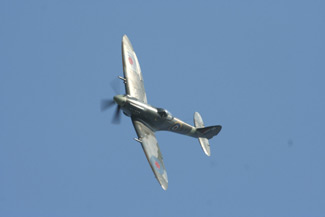
SM845, a Mk XVIII Spitfire built in 1945 and was shipped to Karachi, Pakistan and was received by South East Asia Air Command in February 1946. The aircraft was transferred to the Indian Air Force on 31st December 1947 and issued with the serial number HS687, servicing with the Indian Air Force until the late 1950s.
In later years the aircraft was used as a decoy at Kalaikunda Air Base near Calcutta. The aircraft was acquired by Ormonde and Wensley Haydon-Baillie and was shipped to California in 1978. She was eventually partially-restored by Adrian Reynard in 1988, before being moved to Historic Flying Limited at Audley End in 1992 for completion. Eventually acquired by Historic Flying Limited and with the restoration complete she made her first flight from Audley End on 7th July 2000.
Painted in the colours of 32 Sqn RAF operated Spitfire Mk XVIII SM845 in the far east. The aircraft was based at Duxford Airfield and operated and maintained by The Aircraft Restoration Company.
SM845 is now owned by the norwegian branch Biltema.
The Aircraft Restoration Company website
Photo by Bob Franklin
Supermarine Seafire Mk XVII G-KASX SX336 (VL-105)
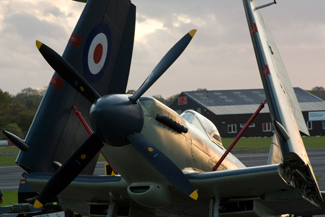
SX336 was recovered from a scrapyard in 1973 and was owned by several people before it was bought by Tim Manna of Kennet Aviation in 2001. After several years of post-restoration SX336 was painted in a Fleet Air Arm colour scheme, before making its first flight on 3rd May 2006. SX336 is the only airworthy Seafire in the UK and one of only two airworthy Seafires in the world.
Photo by Ross Cannon
Supermarine Spitfire Mk XVI CBAF.10895 VH-XVI TB863 (FU-P)
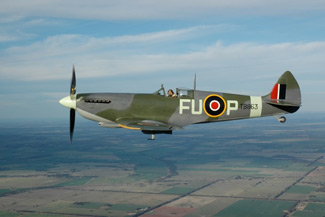
TB863 is based at The Temora Aviation Museum in Australia and is one of only two flying Spitfires in Australia. TB863 was built at Vickers-Armstrong's Castle Bromwich shadow factory, near Birmingham in 1944.
She first saw action on 24th March wearing the squadron code FU-P. She was equipped with two 250lb bombs and a long-range belly tank, TB863 along with three other Spitfires were sent on armed reconnaissance, briefed to bomb rail targets in the Utrecht/Hague/Leiden area. On 17th July 1951 she suffered a takeoff mishap and she was struck off charge as scrap. Later TB863 was purchased by Metro-Goldwyn-Mayer Inc (MGM) as a stage prop for the 1955 film Reach for the Sky, which was based on wartime pilot Douglas Bader.
Twelve years on, TB863 was used in The Battle of Britain film as a spares source for the flying aircraft in the film.
She was transferred to a new owner in December 1968 and moved to Southend. In October 1982, TB863 was moved to Booker, here she underwent restoration and she was given the civil registration of G-CDAN. The aircraft was sold to Stephen Grey of The Fighter Collection and the restoration began in February 1986.
In 1987 the aircraft was sold to Sir Tim Wallis. Once the restoration was completed she was shipped to New Zealand, here she was reassembled and later test flown by Stephen Grey in January 1989 as ZK-XVI. Tim flew the aircraft at the Warbirds Over Wanaka Air Show and many others throughout New Zealand. She was repainted in the exact livery of No. 453 Squadron R.A.A.F including the squadron and aircraft codes ‘FU-P’, this is the colour scheme the aircraft was painted in when it flew its first operational sortie across The English Channel in 1945.
In April 2006 she was bought by The Temora Aviation Museum. The aircraft was disassembled by The Alpine Fighter Collection Team and then shipped to Temora NSW, Australia. Here she was reassembled and registered as VH-XVI. She is regularly flown at their air shows and museum displays.
The aircraft has a 1700 horsepower (1245kW), 27 litre liquid cooled V-12 Rolls-Royce Merlin 266 engine, built by Packard in the USA. With a maximum speed of 416 mph/669 km/h and two 20mm Hispano Cannons.
Temora Aviation Museum website
Photo by Keith Webb
Supermarine Spitfire Mk XVI G-OXVI TD248 (CR-S)
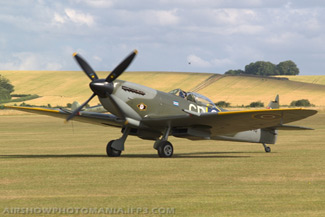
TD248 was built at Castle Bromwich and delivered to No. 6 MU at Brize Norton on 16th May 1945. The aircraft joined 695 Squadron based at Bircham Newton in Norfolk and was coded 8Q-T. The squadron moved to Horsham St Faith near Norwich in August 1945. The aircraft was withdraw from service on 31st December 1947, following unrecorded and substantial damage and eventually returned to service on 13th May 1948 with the codes 4M-E.
TD248 was transferred in August 1951 to No. 2 Civilian Anti-Aircraft Co-operation Unit at Little Snoring in Norfolk. This unit was operated by Marshalls of Cambridge and included calibration and target towing duties.
In May 1954 TD248 was withdraw from service and stored at RAF Cosford. In October 1955 the aircraft was allocated for static display at Hooton Park, Cheshire and later moved to the Air Training Corps at RAF Sealand, where it remained until it was acquired by Historic Flying Limited in 1988. After extensive maintenance including a rebuilt propeller and a zero-timed engine, TD248 was flown again in November 1992, finished in a new paint scheme of silver and red livery of a 41 Sqn Spitfire F21 that participated in the Blackpool Air Races of 1948-49.
The aircraft was sold in 2005 and resprayed in its new colour scheme of 74 Sqn 2nd Tactical Air Force May 1945. It is operated by Spitfires Ltd and maintained by The Aircraft Restoration Company.
The Aircraft Restoration Company website
Photo by Colin Sayce - Airshowphotomania.ifp3.com
Supermarine Spitfire Mk VIII 6S/581740 A58-602 VH-HET (RG-V) Grey Nurse
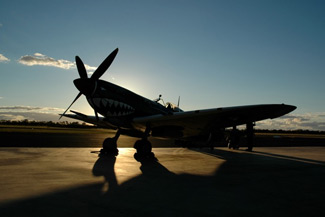
VH-HET is based at The Temora Aviation Museum in Australia and is one of only two flying Spitfires in Australia.
She was built by Supermarine in 1944, test flown and shipped to Australia. VH-HET is one of 1652 Spitfire Mk VIII variants that were built, with an all-metal, semi-monocoque construction and a cantilevered wing. She was the last Spitfire acquired by the Royal Australian Air Force (RAAF), they took delivery of her in April 1945. With the onset of World War II approaching she was placed into storage as she was not required on active service.
Post WWII she was used as an instructional airframe at Sydney Technical College. Later she was acquired by Mr. Sid Marshall, she was stored and disassembled at Bankstown until 1982.
Next she was bought by Mr. Colin Pay of Scone, he undertook a restoration of the aircraft. The restoration was complete in 1985 and she took to the skies once again.
The aircraft is painted in the green and grey camouflage colours worn by the RAAF aircraft defending Darwin during World War II and in operations in the South West Pacific. She carries the markings of Wing Commander R.H. (Bobby) Gibbes AM WG CMR DSO DFC*.
In May 2000 she was acquired by David Lowy and he donated the aircraft to The Temora Aviation Museum in July 2002. She is regularly flown at their air shows and museum displays.
The aircraft is equipped with a 27 litre liquid cooled V-12, 1710 horsepower (1275.66 kW) Rolls-Royce Merlin 70 engine, two 20mm Hispano Cannons and four .303 in. Browning machine guns. She has a maximum speed of 416 mph/669 km/h.
Temora Aviation Museum website
Photo by Keith Webb




